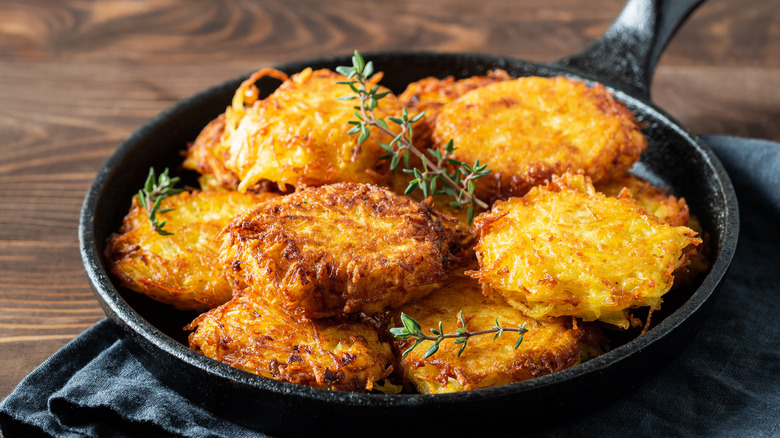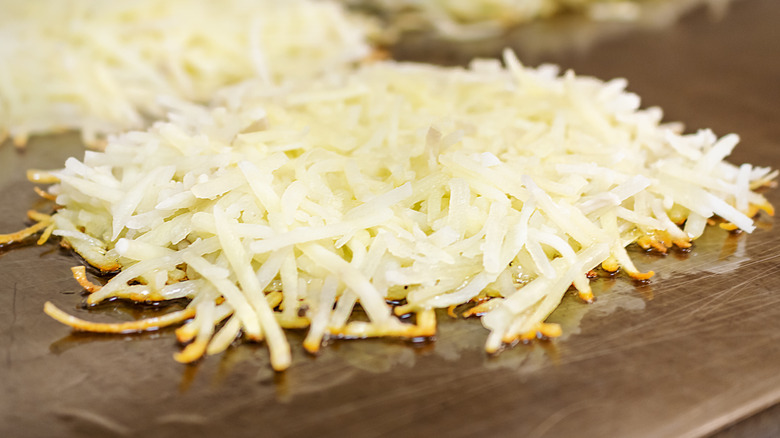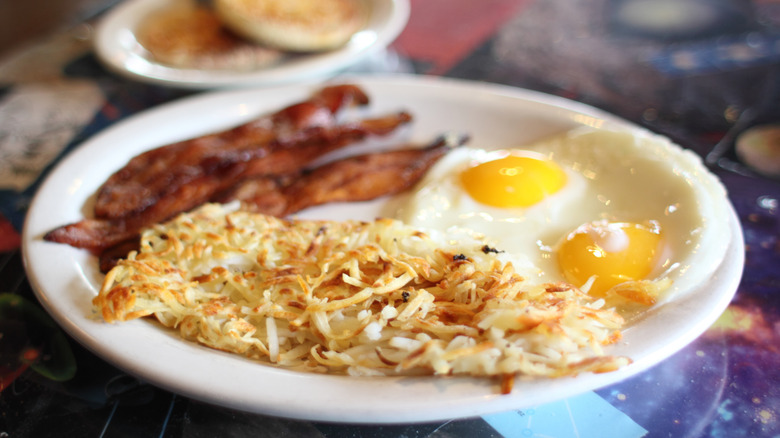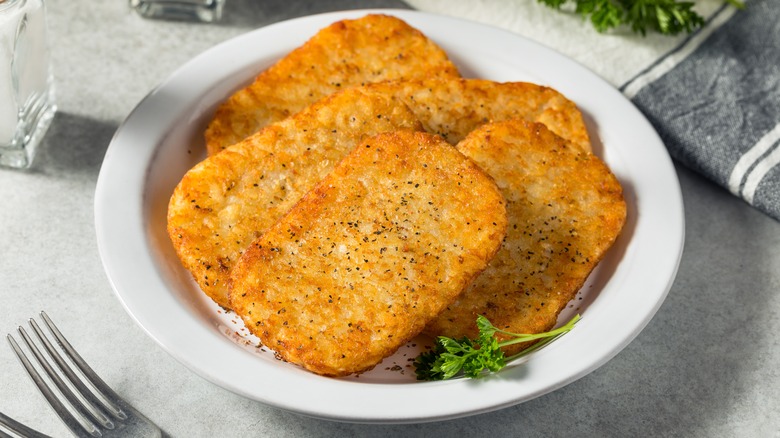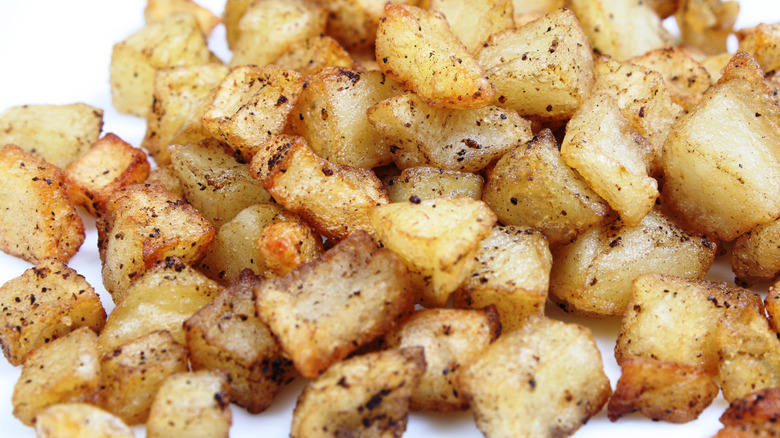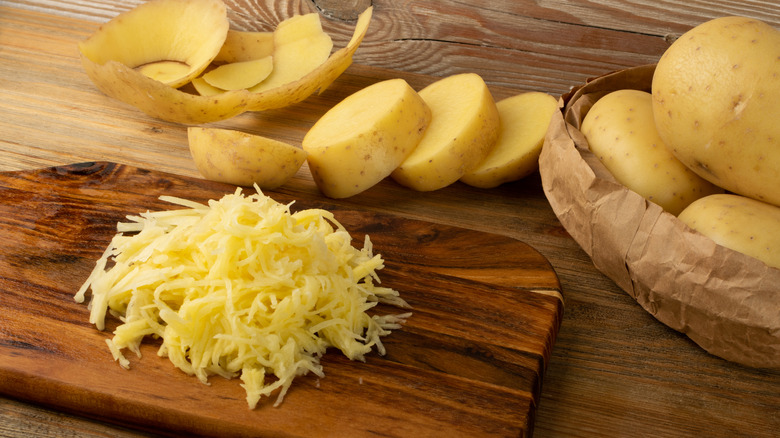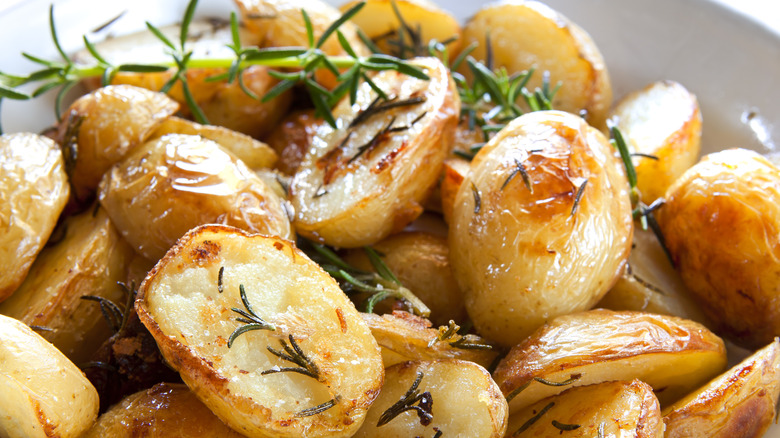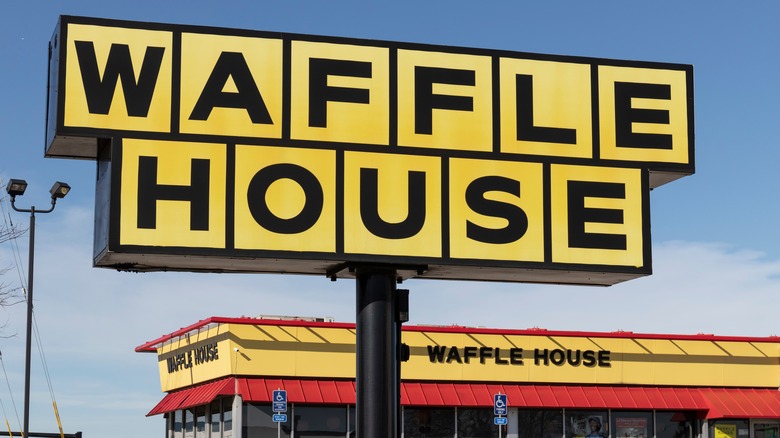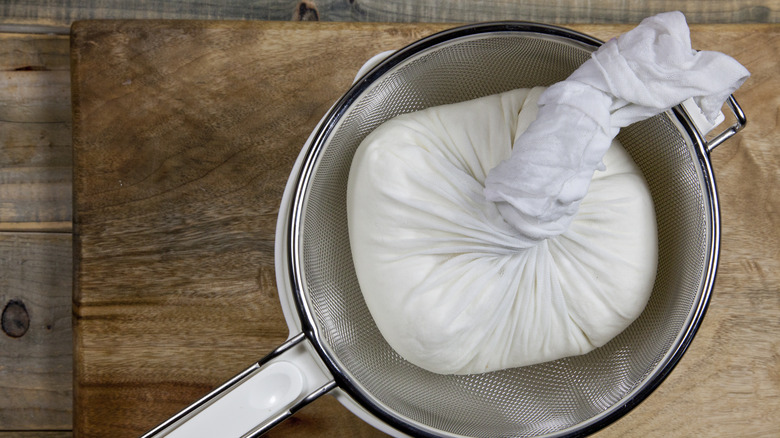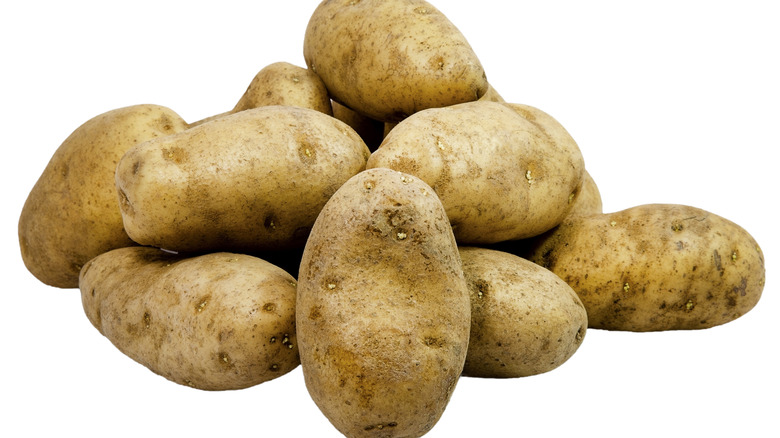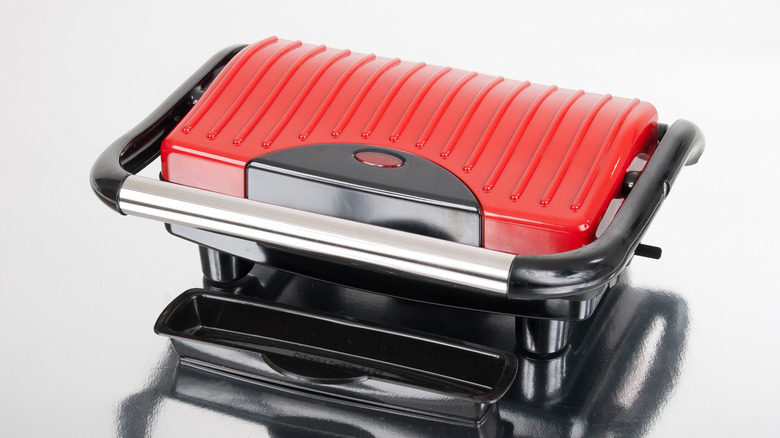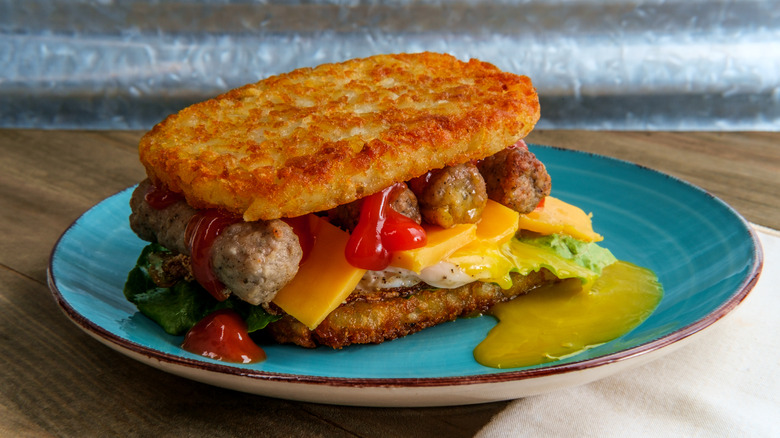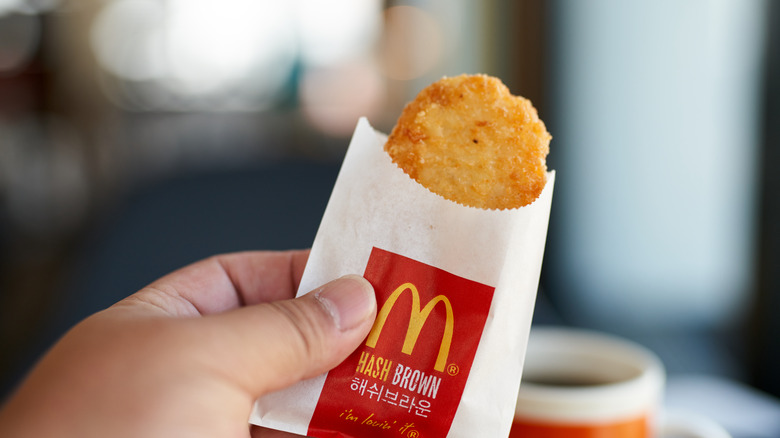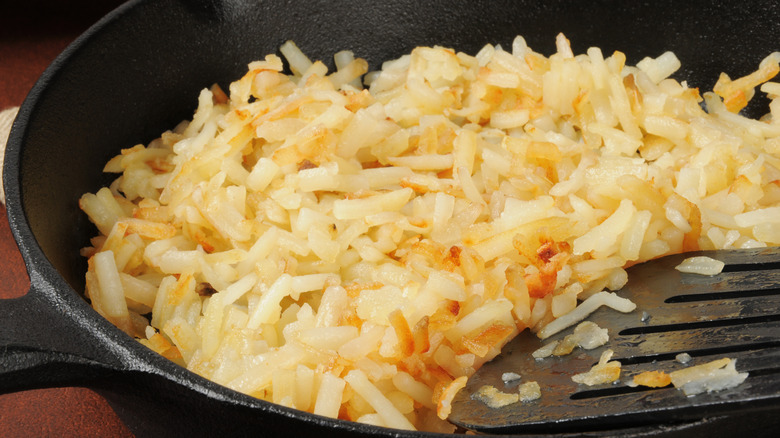Hash Browns: 13 Facts About The Popular Breakfast Food
We may receive a commission on purchases made from links.
Hash browns are a beloved breakfast staple that has been served up on breakfast tables since the late 1600s. They have been a staple dish in the American diet for so long even Martha Washington was considered a fan. The best hash browns are made with the starchy Russet potato, but every variety from Yukon gold to red potatoes to sweet potatoes has been used as a twist on the classic version. From simple, basic formulas of shredded potatoes, salt, pepper, and oil, to more complex recipes involving ham, cheese, or even Waffle House's fan favorite, country-style hash browns covered in sausage gravy.
Although McDonald's takes the cake for best hash browns in a fast food restaurant, there's a brunch joint in Los Angeles that takes hash browns to a whole new level by making them the bread in a breakfast sandwich.
Whether you prefer your hash browns home-cooked, store-bought, or ordered at your local breakfast place, keep reading to learn more about one of the most popular breakfast items on any menu.
1. The original name for hash browns was hashed brown potatoes
From 1896 to the present, there is no agreement on how to title hash browns exactly, according to The Washington Post. According to cookbooks from 1896, as well as more recent titles like "A Real American Breakfast" by Cheryl Alters Jamison and Bill Jamison and "Hash Brown Recipes: A Potato Cookbook with Delicious Hash Brown Recipes" from BookSumo Press, the popular breakfast dish has been called everything from "hashed brown potatoes" to "hashed browned potatoes" to "hash brown potatoes" to simply "hash browns." Nowadays, the dish is most commonly referred to as hash browns, with Waffle House conjoining the words into one straightforward hashbrown on their menu.
No matter how you spell or pronounce it, the word will never lose its core, hash, which dates back to the 1600s and stems from the French word hacher, meaning to chop, grind, or hack.
2. Hash browns were made popular in the 1600s
Though variations of hash browns have been emerging in kitchens and cookbooks since the 1600s, the origins can be traced back to Martha Washington's "Booke of Cookery," which features transcripts from recipe books owned by Martha in the 17th century (a version annotated by Karen Hess was published by Columbia University Press in 1981). As reported in The Washington Post, the book includes three hash recipes – in which leftovers were chopped and cooked — which was the same technique later used to make hash potatoes and meats in America.
By the late 1800s, hash houses were popping up in America, and hash dishes typically consisted of chopped meats and potatoes. Eventually, the recipe was shortened to just potatoes, and recipes for hashed brown potatoes were recorded shortly after. Early recipes also included the use of heavy cream, which is now considered outdated. They were also cooked on one side rather than flipped and crisped on both sides, especially in the early days of the hash. In addition, cooking them in meat fats like bacon or ham was common practice, as it was more convenient and affordable than using oils.
3. The best hash browns include three ingredients
While no one can agree upon a name over the last few centuries, there is one thing that most chefs seem to agree upon, which is that the best hash browns include three main ingredients: potatoes, fat, and salt, per The Washington Post. There is some wiggle room to add onions and black pepper, and some chefs and cookbooks are more adventurous with additions like bacon, bell peppers, ham, or cheese. But the three basic ingredients are a must, and will yield the best result.
The first and most important ingredient is, of course, potatoes. Although you can use just about any potato variety there is, the best choice for hash browns is a Russet potato, as it contains the most starch and will brown best in the frying pan. Any potato — whether mashed, baked, or fried — definitely needs salt, so that is almost as important an ingredient as the potato itself. Lastly, you'll need the right type of fat to brown the potato. Recipes range from using butter to different types of oil to bacon grease to fry the hash browns to golden brown perfection. From there, you can serve it up in all its simple glory, or get creative with other breakfast ingredients to take your hash browns from side dish to main course.
4. Hash browns are not the same as home fries
Let's be clear about one thing on restaurant menus, in cookbooks, and online recipes alike: hash browns are not home fries. Before understanding the difference, it's important to have a firm grasp on what each one means. Hash browns are diced and shredded potatoes that are browned in a pan with some sort of fat, often on both sides, but sometimes just on one side. Home fries are potatoes that have been diced into cubes, and like hash browns, they are cooked in oil in a skillet or frying pan, according to What's the Difference.
The main difference between the two breakfast sides is the way they're prepped, with hash browns being a thin, shredded version of a potato and home fries being a cubed or sliced variation. Other differences include the mix-ins, with hash browns being more popular on their own and home fries typically including bell peppers and onions, as well as a mixture of seasonings like onion powder, garlic powder, or paprika, as taught by Masterclass.
5. Hash browns potatoes turn pink after being cut
When apples are exposed to air, they turn brown. Same with meat, avocado, and many fruits and vegetables, and of course, potatoes, which change color when the phenols and enzymes of the potato react with oxygen. That doesn't mean the potatoes aren't safe to eat, but if the process of oxidation weirds you out in some way, the good news is there's a way to prevent pinkness from happening.
Once the potato is exposed to air, especially when chopped, diced, or shredded into smaller pieces, the pink hue will ensue. However, if you immediately immerse the shredded or chopped pieces in water, you should be able to prevent oxidation from happening.
That's not always the case, as evidenced by a writer with The Takeout, who experienced a dramatic change in color when placing her peeled potatoes in water. However, this occurred in spite of her best efforts due to the amount of potatoes she was working with, and the fact that she was rushing the process, and therefore had some air pockets form in her bucket of water, turning the color a surprising blood red. With time and care, a water bath should eliminate any signs of oxidation prior to cooking your hash browns.
6. You can use previously cooked potatoes to make hash browns
When cooking hash browns, there's always the question whether to start with raw or cooked potatoes, or at least pre-cooked to make the browning process easier. The good news is, if you're making potatoes for dinner, you can skip a step at breakfast by prepping your hash browns with your roasted potatoes the night before, making the overall cooking process easier and healthier.
According to Kaiser Permanente, using already-cooked potatoes is not only a healthier option but also a faster and more efficient one. The only problem with their recipe is that they dice rather than shred the roasted potatoes — which we now know is not technically hash browns, it's home fries. However, if you swap it for shredded potatoes, the method for cooking a healthier hash brown still applies. With less oil in the pan and a shorter cooking time, the result will yield a perfectly cooked, healthier style of hash browns.
7. The Waffle House is known for hash browns as much as waffles
The Waffle House is an oasis of American breakfast food, with a restaurant history deeply-rooted in southern culture, tradition, and of course, cuisine. The waffles are about as iconic as a dish gets, the eggs are always reliable, and the hash browns are so epic they have a language all their own.
The basics are knowing the size of hash browns you want to order, which are referred to as scattered, and range in regular, large, or triple sizes, according to The Atlanta Journal-Constitution. Order regular browns scattered if you want a side of hash browns as basic as they come. There are over a million different ways to order hash browns at the Waffle House, like adding grilled tomatoes, topping them with melted cheese, or country-style smothered in gravy, so if you want to make it fancy, do your research before you go.
The idea to add other ingredients to their famous hash browns was born authentically in the kitchen when Waffle House cooks would add extra toppings to their own hash brown orders, spawning a new twist on the classic, as reported in Garden & Gun.
8. There's a secret to making hash browns perfectly crispy
Getting hash browns to be perfectly crispy is an art form that can be perfected with the right instructions and equipment. The goal in cooking hash browns is to cook them evenly to a light brown crisp on the outside with a creamy, but textured middle. An overly mushy or overly browned to a crisp falls short of perfection, but is a common outcome. The good news is, there are steps you can take to avoid such devastating pitfalls in cooking hash browns.
First, you'll want to place the shredded potatoes in a cheesecloth or tea towel (if you don't have either of those, a thick paper towel or super-clean dish towel will do the trick) and twist it as tightly as you can to remove moisture from the raw potatoes. The next step is to par-cook, or partially cook, the shreds to remove any excess water that didn't wring out in the towel. The best method for par-cooking your hash browns is to zap them in the microwave for a couple of minutes, or boil them and wring them out again. Taking these precautions will get you two steps closer to a perfectly crispy outcome.
9. Russet potatoes make the best hash browns
Sure, you can shred any type of potato in your pantry, but the question really is, should you? Save the red potatoes, Yukon golds, and sweet potatoes for roasting or mashed potatoes, and reach for a Russet every time you make hash browns. Russet potatoes (also known as Idaho potatoes or baked potatoes) are high in starch, which helps hold them together when they're pancaking in the pan fryer.
Choosing a Russet potato is only the first of many decisions you'll need to make when prepping your potato to make hash browns. Some experts recommend soaking the raw, shredded potatoes in an ice bath before wringing them dry with a cloth. Other recipes suggest par-cooking before throwing them in a hot skillet. Although some swear by adding cream to Russet potato hash browns, a writer with The Washington Post does not. Whatever method you choose, just remember the starchy Russet is the best way to start.
10. You can make hash browns in a panini press
Though the verdict is out on whether or not the original hash brown was browned on both sides, The Washington Post reports that it isn't easy to achieve the perfect flip of the pancake with evenly browned crispness on the top and bottom. One way to achieve a perfectly crispy browned outcome on both sides without the hash browns falling apart, breaking in the middle, or cooking unevenly is to cook them in a panini press.
That doesn't mean you don't have to wring them out or par-cook them before throwing them on the panini press, but it does eliminate the use of oil, which also cuts back on the fat in your hash browns. The key to this cooking method is to spread the hash browns evenly across the press, keeping it thin, but not spilling over. This ensures the middle will cook evenly. The panini press also cuts back on the amount of time it takes to cook your hash browns, as they're being cooked from both sides at once, so it's a great technique when you're short on time.
11. Next-level your breakfast sandwich with hash browns
If you're gluten-free or looking to cut back on carbs, but you don't want to sacrifice the perfection and deliciousness that is a breakfast sandwich, try swapping out the bread for hash browns. According to Eater Los Angeles, there's a brunch joint in Culver City that is nothing short of epic thanks to the hash brown replacement for bread. That's not to say it's easy to recreate, as the ingredients involved in this work of art are given high priority in the kitchen, and involve a labor of love to bring it to a level of perfection.
But that doesn't mean all is lost, especially if you live outside of the Los Angeles area, which most of us do. There's always the ever-reliable Drive Thru window of McDonald's, where you could deconstruct a breakfast sandwich and make your own twist on the gluten-free option. Or take your sandwich game to new heights by slipping a hash brown right smack in the middle.
12. McDonald's has some of the best hash browns on the planet
It's hard to mention hash browns without thinking about the crispy oval patty hash brown that comes in the perfect holding sleeve from none other than McDonald's. In a Mashed poll, voters chose McDonald's hash browns over their competitors like Chick-fil-A, Burger King, and Taco Bell with a whopping 39% of the votes. Toasty on the outside with a fluffy, light interior, McDonald's has mastered the art form, and the people have spoken. McDonald's hash browns can also be ordered well-done, just like their french fries, if you want to take the crispy factor up a notch.
That doesn't mean you have to race to the Drive Thru every time you crave one of those crispy, greasy oval nuggets from McDonald's; try slaying one at home with a copycat from Trader Joe's or your local grocery store. Even though McDonald's hash browns aren't the worst thing on their menu in terms of ingredients, buying them from the store may save you some preservatives and saturated fats.
13. Hash browns can be healthy or unhealthy, depending on how they are cooked
Hash browns are not necessarily an unhealthy food, though they can be loaded with saturated fats and calories depending on how they're cooked and what they are prepared with. Healthline points out that the skin is the most nutrient-dense part of the potato, especially an otherwise starchy Russet potato. Although the nutrients and vitamins differ depending on the potato variation, the Russet potato contains vitamins B12 and C, as well as fiber, sodium, potassium, and protein.
When cooked in a pan or panini press without the use of fatty oils, hash browns are actually considered a low-calorie food and are a great substitute for items with gluten on the breakfast menu. But when they're deep-fried (a commonly used practice at restaurants to maintain the consistency of their hash browns), the outcome is a more indulgent breakfast side dish that is higher in saturated fats. The other high-calorie version includes high-fat ingredients like melted cheese, sausage, or ham.
The best bet for the healthiest version of hash browns is to cook them at home, so you can control the oil and salt content as well as the cooking method.
